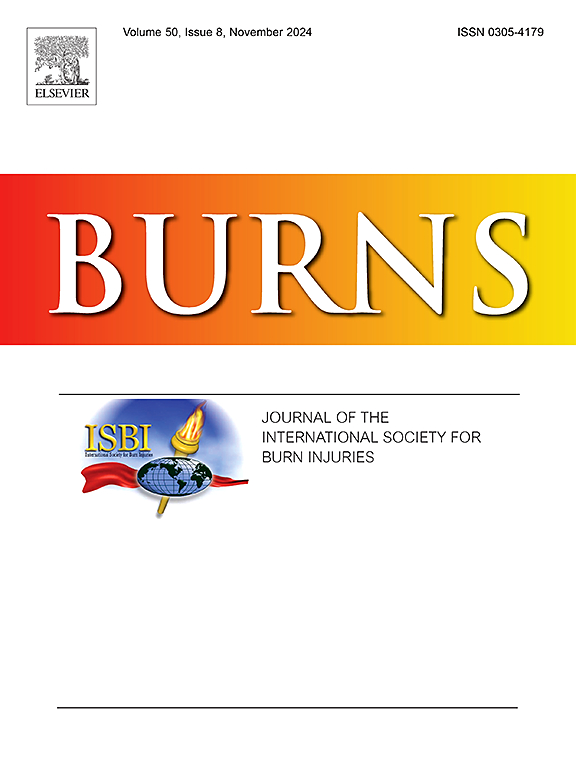Early Laser for Burn Scars (ELABS) - Randomised controlled trial of pulsed dye laser treatment and standard care versus standard care alone for the treatment of hypertrophic burn scars
IF 3.2
3区 医学
Q2 CRITICAL CARE MEDICINE
引用次数: 0
Abstract
Background
Hypertrophic burn scarring (HBS) is described as “the greatest unmet challenge after burn injury”. This ELABS trial hypothesised that early pulsed dye laser (PDL) treatment of HBS improves both scar quality and quality of life (QoL).
Methods
A parallel arm randomised controlled trial to assess the effectiveness and cost-effectiveness of PDL was undertaken at seven centres in the UK. Patients were eligible if their burn injury was within three months of wound healing, and ineligible either with history of keloid scarring or aged < 16 years. A total of 153 (77 male, 76 female) participants were recruited between Nov 17, 2021, and Jun 30, 2023, and were randomised using software in a 1:1 ratio stratified by study centre; 138 (69 each arm) were included in the final complete-case analysis. Both study arms received standard care, and the intervention arm received three PDL treatments. The primary outcome was patient-rated scar quality (POSAS) at six months. The trial was registered with International Standard Randomised Controlled Trial Number registry (ISRCTN14392301).
Findings
Early PDL showed a statistically significant improvement in patient-rated scar quality (p = 0·041) and the secondary outcome, participant’s perception of change in scar quality (p = 0·01), at six months. There were no statistically significant differences for Quality-of-Life, observer-rated POSAS scar quality, or colour measurement. Early PDL was not cost-effective at 6 months follow-up for the willingness-to-pay threshold of £20,000 per Quality-Adjusted-Life-Year (QALY). There were no unexpected adverse events related to the intervention.
Interpretation
Early PDL treatment of HBS is safe and shows improvement for patient-rated scar quality but not QoL at six months. As scar maturation is prolonged and dynamic, longer-term follow-up of upwards of two years is required both to understand the eventual clinical effect on scar outcome and to make any definitive conclusion concerning cost-effectiveness.
早期激光治疗烧伤疤痕(ELABS) -脉冲染料激光治疗和标准护理与单独标准护理治疗增生性烧伤疤痕的随机对照试验
背景肥厚性烧伤瘢痕(HBS)被描述为“烧伤后最大的未解决的挑战”。这项ELABS试验假设,早期脉冲染料激光(PDL)治疗HBS可改善疤痕质量和生活质量(QoL)。方法在英国7个中心进行了一项平行随机对照试验,以评估PDL的有效性和成本效益。如果患者的烧伤在三个月内伤口愈合,则不符合条件,如果有瘢痕形成史或年龄在 16岁,则不符合条件。在2021年11月17日至2023年6月30日期间,共招募了153名参与者(77名男性,76名女性),并按研究中心按1:1的比例使用软件随机分组;138例(每组69例)被纳入最终的完整病例分析。两个研究组均接受标准治疗,干预组接受三种PDL治疗。主要结果是6个月时患者评价的疤痕质量(POSAS)。该试验已在国际标准随机对照试验号注册中心注册(ISRCTN14392301)。发现早期PDL在患者评价的疤痕质量(p = 0.041)和次要结局,参与者对疤痕质量变化的感知(p = 0.01)六个月时具有统计学意义的改善。在生活质量、观察者评价的POSAS疤痕质量或颜色测量方面没有统计学上的显著差异。对于每个质量调整生命年(QALY) 2万英镑的支付意愿阈值,早期PDL在随访6个月时并不具有成本效益。没有与干预相关的意外不良事件。解释:HBS的早期PDL治疗是安全的,并且在6个月时显示出患者评价的疤痕质量的改善,但没有改善生活质量。由于疤痕成熟是长期的和动态的,需要两年以上的长期随访,以了解疤痕结局的最终临床效果,并得出任何关于成本效益的明确结论。
本文章由计算机程序翻译,如有差异,请以英文原文为准。
求助全文
约1分钟内获得全文
求助全文
来源期刊

Burns
医学-皮肤病学
CiteScore
4.50
自引率
18.50%
发文量
304
审稿时长
72 days
期刊介绍:
Burns aims to foster the exchange of information among all engaged in preventing and treating the effects of burns. The journal focuses on clinical, scientific and social aspects of these injuries and covers the prevention of the injury, the epidemiology of such injuries and all aspects of treatment including development of new techniques and technologies and verification of existing ones. Regular features include clinical and scientific papers, state of the art reviews and descriptions of burn-care in practice.
Topics covered by Burns include: the effects of smoke on man and animals, their tissues and cells; the responses to and treatment of patients and animals with chemical injuries to the skin; the biological and clinical effects of cold injuries; surgical techniques which are, or may be relevant to the treatment of burned patients during the acute or reconstructive phase following injury; well controlled laboratory studies of the effectiveness of anti-microbial agents on infection and new materials on scarring and healing; inflammatory responses to injury, effectiveness of related agents and other compounds used to modify the physiological and cellular responses to the injury; experimental studies of burns and the outcome of burn wound healing; regenerative medicine concerning the skin.
 求助内容:
求助内容: 应助结果提醒方式:
应助结果提醒方式:


